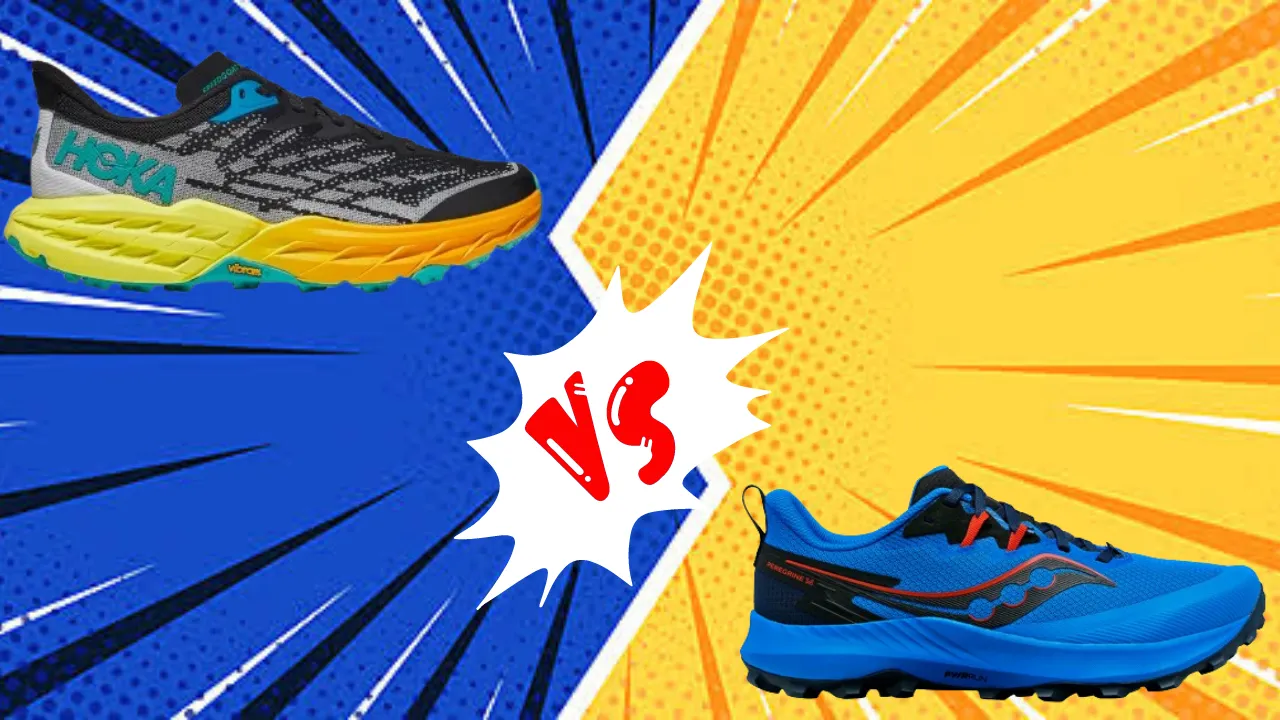Are you an avid trail runner seeking the perfect pair of shoes to conquer the rugged outdoors? Look no further than the Hoka Speedgoat 5 and Saucony Peregrine 14, two formidable contenders vying for the top spot in your gear arsenal.
In this comprehensive comparison, we’ll delve deep into the intricate details, unraveling the strengths and weaknesses of each shoe to help you make an informed decision. Get ready to embark on an exhilarating journey as we explore which option reigns supreme for your trail-running adventures.
Similarities And Differences Between Hoka Speedgoat 5 And Peregrine 14:
| Feature | Hoka Speedgoat 5 | Saucony Peregrine 14 |
|---|---|---|
| Launched In | 2022 | 2022 |
| Stability | Good, especially for a high stack height shoe | Neutral |
| Flexibility | Not very flexible | Flexible |
| Weight | 10.76 oz (per shoe, size 10.5) | 9.4 oz |
| Cushion | Dense | PWRRUN |
| Out Sole | Vibram Megagrip rubber with Traction Lug | PWRTRAC |
| Mid Sole | CMEVA Energy Save PU foam with Profeel Film rock protection | PWRRUN |
| Upper Sole | Recycled engineered mesh | Reimagined upper |
| Retail Price | $154.95 at Backcountry, $130.28 at Amazon | $139.95 |
Features Comparison:
Material: Outsole, Insole, Upper Sole
The Hoka Speedgoat 5 boasts a formidable Vibram Megagrip rubber outsole with a Traction Lug, ensuring unrivaled grip on even the most treacherous trails.
Its recycled engineered mesh upper not only contributes to its eco-friendly nature but also provides breathable comfort. The CMEVA Energy Save PU foam midsole, complemented by the Profeel Film rock protection, offers a perfect blend of cushioning and durability.
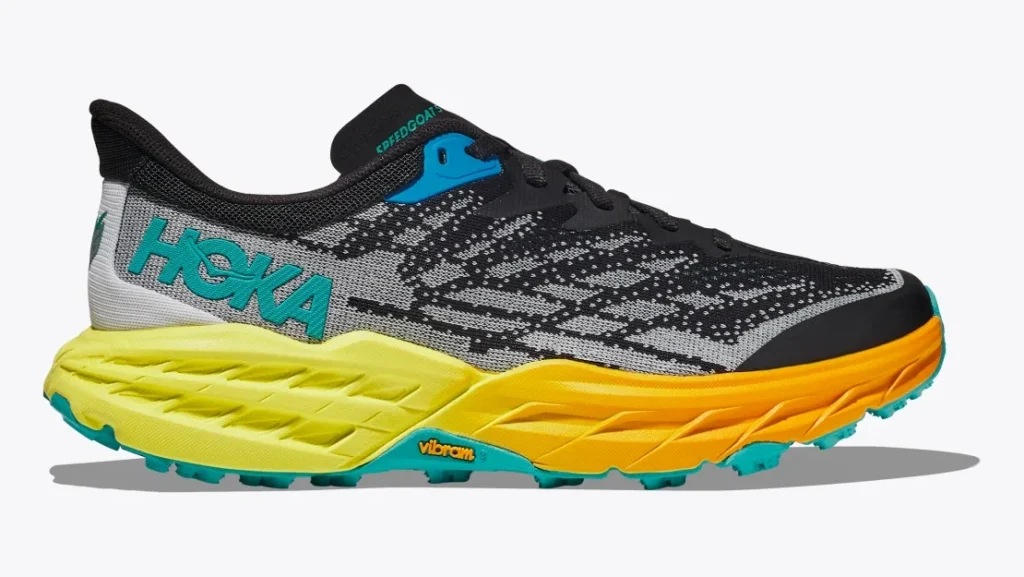
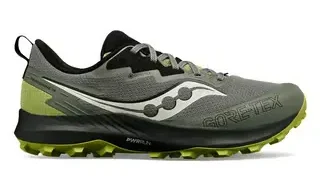
On the other hand, the Saucony Peregrine 14 features a PWRTRAC outsole, designed to deliver reliable traction on various trail surfaces. The reimagined upper promises enhanced comfort, while the PWRRUN midsole offers a responsive and cushioned ride. Both shoes prioritize durability and performance, making them suitable for tackling challenging terrain.
Durability:
Both shoes prioritize durability for tackling tough trails. The Hoka Speedgoat 5’s Vibram Megagrip rubber outsole is renowned for its exceptional longevity, ensuring long-lasting traction. Its CMEVA Energy Save PU foam midsole retains cushioning over time.
Saucony’s PWRTRAC outsole on the Peregrine 14 resists wear, providing a reliable grip. While midsole durability isn’t specified, Saucony’s quality craftsmanship suggests it’s built to withstand repeated use. These durable designs allow the shoes to perform mile after mile.
Fit:
The Hoka Speedgoat 5 is lauded for its wide platform, providing exceptional stability, especially for a shoe with such a high stack height. This design ensures a secure and confident stride, even on uneven terrain, though the overall volume may not suit runners with narrower feet.
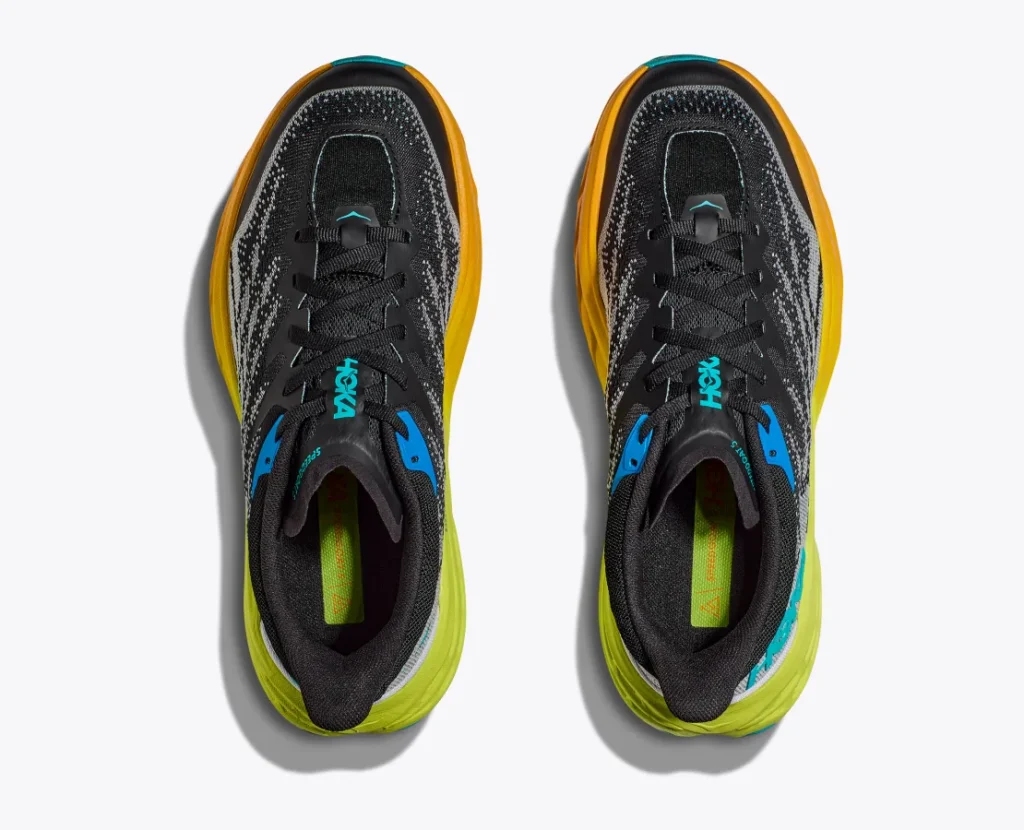
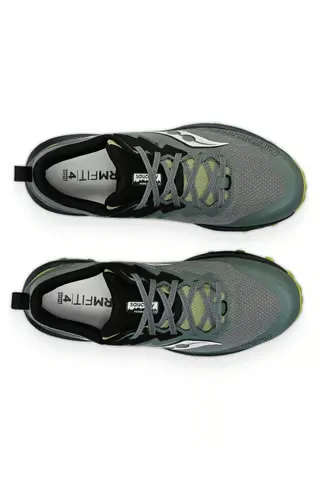
The Saucony Peregrine 14’s reimagined upper promises a comfortable fit tailored to the unique contours of your foot. While specific details are limited, Saucony’s innovative design suggests the Peregrine 14 will deliver a snug yet flexible fit, ideal for optimal trail performance.
Stability:
Stability is crucial on challenging trails, and both shoes excel in this area. The Hoka Speedgoat 5 offers excellent stability thanks to its wide platform and high stack height, providing a solid base and preventing excessive foot roll.
However, the higher stack height can cause instability on off-camber terrain. The Saucony Peregrine 14, being a neutral shoe, provides adequate stability for most trail runners with its flexible design and lower profile.
Cushioning:
When it comes to cushioning, the Hoka Speedgoat 5 and Saucony Peregrine 14 cater to different preferences. The Speedgoat 5 is renowned for its dense cushioning, providing exceptional impact protection and comfort during long runs or descents thanks to its CMEVA Energy Save PU foam midsole and high stack height.
On the other hand, the Peregrine 14’s PWRRUN cushioning aims to strike a balance between responsiveness and shock absorption, offering a comfortable yet efficient ride.
Value for Money
When it comes to value, both shoes offer compelling propositions. The Hoka Speedgoat 5, priced around $155 at Backcountry and $130 at Amazon, is a worthwhile investment for serious trail runners seeking exceptional cushioning, stability, and durability in a long-lasting, high-performance shoe.
The Saucony Peregrine 14, at $140, presents a more budget-friendly option without sacrificing quality or performance. Its lightweight design, responsive cushioning, and reliable traction offer excellent value, especially for those seeking an all-around trail running shoe.
Performance Comparision:
for Walking:
The Hoka Speedgoat 5 excels for long-distance trail walking with its exceptional cushioning, dense midsole, high stack height, and wide platform for superior impact protection and stability.
The Saucony Peregrine 14 shines in agility and responsiveness on technical trails due to its lower profile, flexible design, lightweight construction, and responsive cushioning.
for Running:
For trail running, the Hoka Speedgoat 5 prioritizes maximum cushioning, comfort, and impact protection during long runs with elevation changes, thanks to its dense midsole and high stack height.
The Saucony Peregrine 14 emphasizes agility, responsiveness, ground feel, and nimbleness on technical terrain with its flexible design, lower stack height, and lightweight construction.
for Plantar Fasciitis:
The Hoka Speedgoat 5’s dense cushioning, high stack height, exceptional impact protection, and stable design make it an excellent choice for runners with plantar fasciitis.
The Saucony Peregrine 14, while comfortable and responsive, may not provide the same level of cushioning and support, except for mild cases or minimalistic approaches.
for Standing All Day:
The Hoka Speedgoat 5 is an outstanding option for prolonged standing with its dense cushioning, high stack height, impact protection, and stable wide platform reducing fatigue.
The Saucony Peregrine 14’s lower stack height and more flexible design may not offer the same level of cushioning and support for extended periods on your feet.
final verdict:
Choosing between the Hoka Speedgoat 5 and Saucony Peregrine 14 boils down to your specific needs and preferences. If maximum cushioning, superior impact protection, and exceptional stability during long runs or races with elevation changes are priorities, the Hoka Speedgoat 5 is an outstanding choice.
However, if you value agility, responsiveness, and a more connected ground feel, especially on technical terrain or faster-paced runs, the Saucony Peregrine 14 could be the better fit.
For those with plantar fasciitis or requiring extra support during prolonged standing, the Hoka Speedgoat 5 may be more suitable. Ultimately, both shoes excel in their respective strengths, and your decision should align with your individual running style and trail demands.

